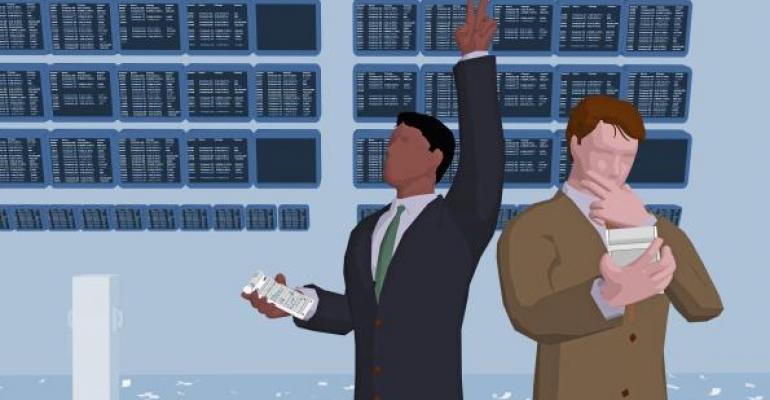The opening line of Charles Dickens’ A Tale of Two Cities begins with, “It was the best of times, it was the worst of times”. The rest of Dickens’ opening, which is less known, continues the pattern of contrasts and extremes. The opposing pairs in the opening passage introduce one of the novel’s most prominent motifs: paired characters and settings replete with rich contrasts despite their links and likenesses. Similarly, trading last week was a series of contrasts and extremes in seemingly paired markets.
The November payroll data from the Bureau of Labor Statistics showed a 321K gain – the largest monthly increase since January 2012. Since expectations were for an increase of 230K, the data was well received. The October figure was revised from 214K to 243K, a continuation of the pattern of strong adjustments. The actual unemployment rate held steady at 5.8%, which continues to match lows last seen in July 2008.
With the improved tone in the labor market, U.S. rates rose by as much as 22 basis points as investors recalibrated their expectations around the Federal Open Market Committee’s timeline on rate increases. The front of the curve bore the brunt of last week’s sell-off as trading pushed this segment of the curve 20 plus-basis points higher. The longer end of the curve outperformed on a relative basis as the 30-year rate rose by 8 basis points.
The curve finished on Friday with all but one relationship flattening. The spread between 2-year and 10-year Treasuries dropped by 3 basis points, finishing the week at 166 basis points. This level would put the relationship at its lowest levels on a closing basis since June 2013. The exception to the flattening trend was the 2-year/5-year spread, which widened by 3 basis points as the 5-year segment of the curve was the worst performer on the week.
On the European front, the European Central Bank left rates unchanged. The main refinancing facility remained at 0.05%; the rate on the marginal lending facility at 0.30%, and the rate on the depository facility at -0.20%. The release was generally viewed as disappointing due to the fact that the market had hoped the ECB would have outlined some type of quantitative easing program. However, with the Germans vehemently opposed to any type of QE the introduction of any such program would likely require a continued deterioration in European growth.
Apart from the U.S.’s improving employment picture, last week’s big story was in the currency market. The strength of the U.S. dollar juxtaposed against the precipitous declines in the euro, yen, and ruble created true sets of contrasts. The dollar rallied to new highs (89.46), levels last seen in March 2009, as the rest of the currency complex appeared to crumble under market forces. The weakness in the yen (121.69), the euro (1.23), and the ruble (54.87) pushed levels to multi-year lows.
Driving the divergent behavior in the currency markets is a combination of economic weakness, disappointing monetary policy, and falling oil prices. The ruble hit 54.87 (down 4% on the week) as the ongoing capital flight forced the Central Bank of Russia to spend $1.9 billion to support the currency. The drop in the yen is beginning to reach levels that are problematic for the domestic Japanese economy. The weaker currency is making imports dramatically more expensive and without the ability to pass along price increases the number of Japanese bankruptcies is beginning to swell. The lack of a tangible plan from Abe and the Bank of Japan is only exacerbating the decline.
Lastly, falling growth rates combined with the ECB’s attempts to “talk the market higher” resulted with the euro dropping to 1.23 – a level not seen since September 2012. The drop is a clear message from investors that the current plan of action is insufficient.
Global sovereign rates finished the week mixed as larger economies saw rates push higher while rates in peripheral countries rallied on stimulus hopes. German Bund rates rose by 5 basis points as yields rose to 0.78%. The spread between Bunds and Treasuries finished the week at 152 basis points – one basis point wider on the week. Asian sovereign rates generally fell as the prospect of new stimulus programs drove the buying.
As we close the week, the markets are forming a picture dominated by extremes; the myriad of news highs positioned against markets making new lows. Contrasts that would ordinarily not be logical are now the norm. The complexities of monetary policy, falling oil prices, and political stability are pushing inter-market relationships in both directions that make sense, and in directions that are counterintuitive.
The improving U.S. employment picture, and the ongoing drop in energy prices, is making domestic investments very compelling versus global alternatives. Conversely, the weakness in Europe and Asia is pushing investors to seek better alternatives for growth. Like the opening of A Tale of Two Cities the global markets are beginning to look paired opposites- similar characters with very different circumstances. However, as relationships between pairs become stretched it is important to recognize that globalization has inextricably linked these markets and the growing divergence is not sustainable in the long term.
Sean Fallon, CFA, is Senior Vice President of Stephens Inc. He joined Stephens in July 2012 to head the Municipal Taxable efforts and to trade CMBS, Agency CMBS, and ABS. He has 19 years of experience managing and trading fixed income assets.




